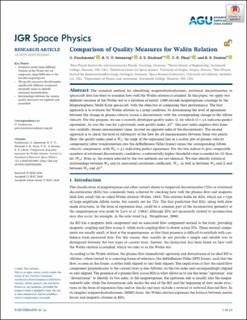| dc.description.abstract | The standard method for identifying magnetohydrodynamic rotational discontinuities in spacecraft data has been to examine how well the Walén relation is satisfied. In this paper, we apply two different versions of the Walén test to a database of nearly 1,000 dayside magnetopause crossings by the Magnetospheric Multi-Scale spacecraft, with the objective of comparing their performance. The first approach is to evaluate the Walén relation as a jump condition, by determining the level of agreement between the change in plasma velocity across a discontinuity with the corresponding change in the Alfvén velocity. For this purpose, we use a recently developed quality index, Q, for which Q=±1 indicates perfect agreement. As was the case for a previously used quality index, ΔV∗, this new index employs data from two carefully chosen measurement times, located on opposite sides of the discontinuity. The second approach is to check the level of Alfvénicity of the flow for all measurements between those two points. Here, the quality index used is Wsl, the slope of the regression line in a scatter plot of plasma velocity components (after transformation into the deHoffmann-Teller frame) versus the corresponding Alfvén velocity components, with Wsl=±1 indicating perfect agreement. For the two indices to give comparable numbers of rotational discontinuity candidates, a substantially higher threshold value is needed for |Q| than for |Wsl|. Even so, the events selected by the two methods are not identical. We also identify statistical relationships between Wsl and its associated correlation coefficient, Wcc, as well as between Wsl and Q and between Wsl and ΔV∗. | en_US |

